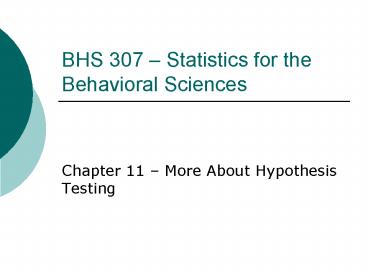BHS 307 Statistics for the Behavioral Sciences - PowerPoint PPT Presentation
1 / 11
Title:
BHS 307 Statistics for the Behavioral Sciences
Description:
The first step in any study is to test against chance. ... conclusions about our results without making sure our results are not accidental. ... – PowerPoint PPT presentation
Number of Views:44
Avg rating:3.0/5.0
Title: BHS 307 Statistics for the Behavioral Sciences
1
BHS 307 Statistics for the Behavioral Sciences
- Chapter 11 More About Hypothesis Testing
2
Why Hypothesis Tests?
- The first step in any study is to test against
chance. - We cannot draw any conclusions about our results
without making sure our results are not
accidental. - We never know for sure what the true situation
is, but we try to minimize possibility of error.
3
Hypothesis Test Outcomes
- A hypothesis test has four possible outcomes
- H0 is true and H0 is retained a correct
decision. - H0 is true but H0 is rejected a Type I error
(false alarm). - H1 is true and H0 is rejected (H1 is retained)
a correct decision. - H1 is true but H1 is rejected and H0 is retained
a Type II error (miss).
4
Strong and Weak Decisions
- Retaining the null hypothesis (H0) is a weak
decision because it is ambiguous and
uninformative. - H0 could be true but is not probably true.
- Rejecting the null hypothesis is a strong
decision because it implies that H0 is probably
false.
5
Decisions are Usually Correct
- We never actually know what is true, H0 or H1.
- Our test procedure produces a result that is
usually correct when H0 is either true or
seriously false. - Type I error rejecting a true null hypothesis.
- Type II error retaining a false null hypothesis.
6
Probabilities of Error
- Probability of a Type I error is a.
- Most of the time a .05
- A correct decision exists .95 of the time (1- .05
.95). - Probability of a Type II error is b.
- When there is a large effect, b is very small.
- When there is a small effect, b can be large,
making a Type II error likely.
7
Influence of Sample Size
- Increasing the sample size decreases the standard
error of the mean sx. - A smaller standard error results in less overlap
between true and hypothesized distributions. - Both distributions shrink toward their true
means. - To reduce the possibility of Type II error,
increase the sample size.
8
Sample Sizes
- Too large may produce an extra sensitive test
that detects very small, unimportant effects. - Too small produces an insensitive test that
will miss even a very large, important effect. - Sizes in the 100s are too large, less 5 is too
small.
9
Power Curves
- Power equals the probability of detecting an
effect. - Power 1 - b
- Power curves show how power varies with sample
size. - They do not predict the true effect size but
specify what sample size will show an effect if
it is present. - A way around arbitrary sample sizes.
10
One-Tailed Two-Tailed Tests
- Two-tailed tests (nondirectional) divide the
probability of error (a) between the two tails. - Expressed using equality signs.
- One-tailed tests (directional) place all of the
probability of error in a single tail in the
direction of interest. - Expressed using inequality signs (lt, gt)
11
Deciding Which to Use
- When identifying the type of test in an exam
question or report - If the null hypothesis is expressed using
inequalities, it is directional. - When choosing a test-type during research
- Use a non-directional (two-tailed) test unless
you have a strong reason to do otherwise.































